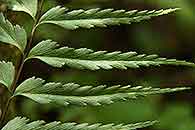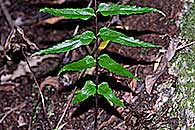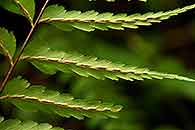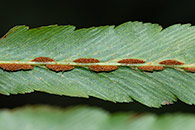Asplenium friesiorum C. Chr.
Synonyms |
Asplenium serra Langsd. & Fisch. var. natalensis Baker |
|---|---|
Common name |
|
Description |
Rhizome widely creeping, branched, up to 8 mm diameter; rhizome scales shiny brown, up to 5 mm long, narrowly triangular in outline, apex tapering to a point, entire. Fronds widely spaced, not proliferous, pendent, thinly coriaceous. Stipe up to 70 cm long, dark brown, sparsely set with brown scales becoming glabrous with age. Lamina up to c. 1m long and c. 25 cm wide, pinnate to 2-pinnatifid, narrowly oblong to lanceolate in outline, basal pinnae somewhat reduced, apical segment deeply pinnatifid or less often the apical pinnae decrescent. Pinnae 14-35 pairs, up to 14 × 2.3 cm, linear-lanceolate in outline, alternate or subopposite, mostly shortly petiolate, hairless but for scattered pale brown scales c. 1 mm long, margins incised, incisions 1/3 to 2/3 of the way towards the midrib into toothed lobes, base unequally cuneate, apex tapering to a point, veins forked and at very sharp angle with costa. Sori linear to oblong, 3-9 x 1-3 mm, set almost continuous in two lines along the midrib, indusium linear, entire, membranous, c. 1 mm wide. |
Notes | Differs from similar species by not having proliferous fronds, the rhizome is widely creeping and the sori are set in the same line along the midrib. |
Derivation | friesiorum: probably named after R.E. Fries (1876-1966), a Swedish botanist who joined the Swedish Rhodesia-Congo Exp. (1911-1912) |
Habitat | Deep shade in moist evergreen forest, bamboo forest, swamp forest, riverine thicket, among boulders in montane grassveld. Terrestrial or lithophytic. |
Distribution worldwide | See African distribution. |
Distribution in Africa |
Angola, Burundi, Cameroon, Congo, Dem. Republic of Congo, Equatorial Guinea (incl. Bioko), Ethiopia, Kenya, Malawi, Mozambique, Nigeria, Rwanda, South Africa, Sudan and South Sudan, Tanzania , Uganda, Zambia, Zimbabwe. |
Growth form |
Lithophytic, terrestrial. |
Literature |
|








